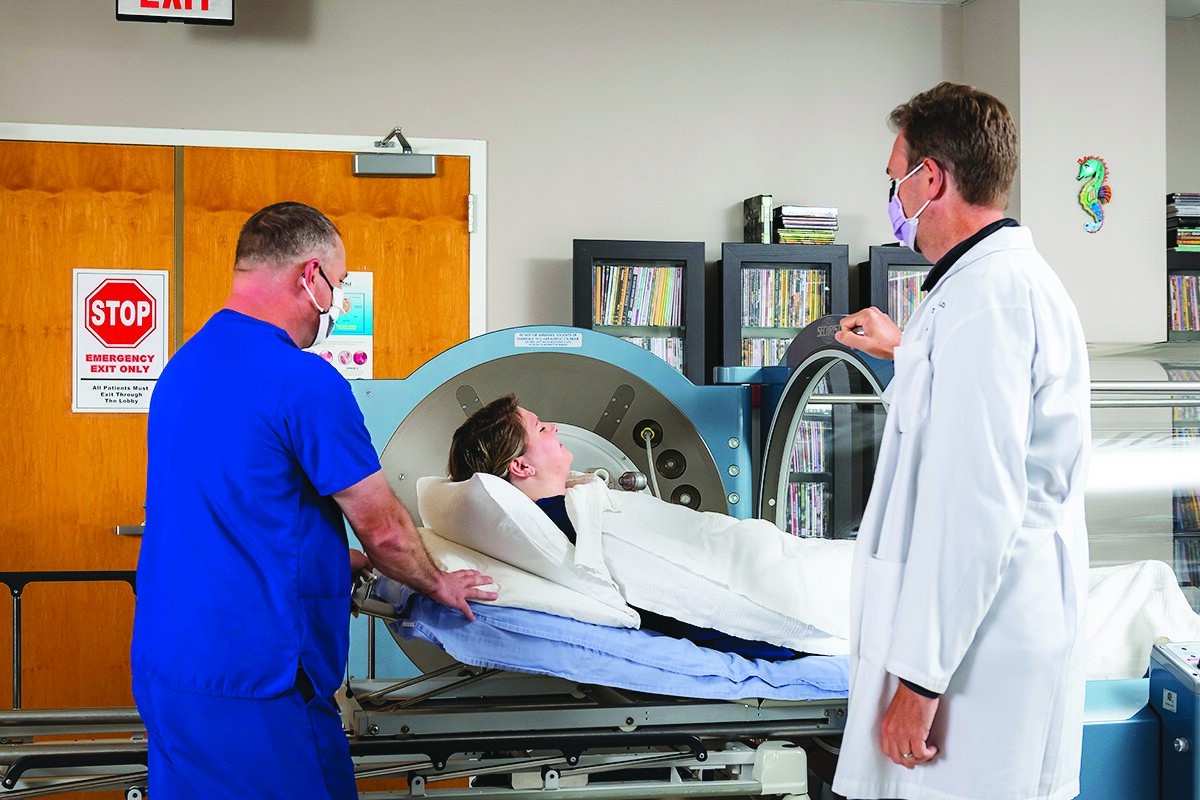Each year in the United States, more than a million people are diagnosed with invasive cancer, and about half will need radiation therapy as part of their care. While radiation is highly effective, clinical trials show that 3% to 5% of patients may face delayed side effects such as soft tissue radionecrosis or slow wound healing.
For metastatic breast cancer survivors, these complications can mean ongoing pain, changes in tissue health, and a more challenging road to recovery. Hyperbaric oxygen therapy (HBOT) offers a supportive, evidence-based option that helps restore blood flow, repair damaged tissue, and enhance long-term comfort and healing.
Continue reading to learn how the best hyperbaric oxygen therapy in Metro Atlanta and North Georgia can treat tissue radionecrosis and other soft tissue injuries.
Can Hyperbaric Oxygen Therapy Work for Radiation Injury?
HBOT is a non-invasive treatment that delivers medical-grade oxygen at higher-than-normal pressure inside a special chamber. Under these conditions, your blood becomes super-charged with oxygen, allowing it to reach areas of the body where circulation has been damaged by radiation.
This extra oxygen helps the body repair blood vessels, reduces inflammation, and provides soft tissues with the support they need to repair and heal. Clinical studies show that HBOT is especially effective for breast cancer survivors who develop soft tissue radionecrosis after radiation therapy, with benefits including improved tissue health, reduced pain, fibrosis, oedema, and shoulder movement.
Can HBOT Help with Pain, Scarring, and Tissue Damage After Breast Cancer Radiation?
After receiving a high radiation dose, some breast cancer survivors experience long-term tissue damage that affects the part of the body treated. This damage often increases the risk of poor wound healing, pain, and decreased mobility. Hyperbaric oxygen therapy works by forcing high levels of oxygen into damaged tissues, allowing it to reach cells far beyond the normal limits of blood supply and support healing where circulation alone cannot.
In the short term, many patients notice reduced pain and inflammation, while over time HBOT stimulates the release of growth factors that repair soft tissue and support lasting recovery. By strengthening the immune system and promoting healthier circulation, HBOT can enhance skin and tissue health, allowing individuals to return to their daily routines and physical activities sooner and with greater comfort and confidence.
What Does an HBOT Treatment Plan Look Like for Breast Cancer Survivors?
An HBOT treatment plan for breast cancer survivors is designed to be both thorough and patient-friendly:
- Most people undergo 30 to 40 sessions, each lasting approximately 90 minutes inside a comfortable hyperbaric chamber.
- The therapy itself is painless and non-invasive. Many patients simply rest, listen to music, or even nap while breathing medical-grade oxygen under pressure.
Because every survivor’s healing journey is different, board-certified doctors tailor each plan to the individual, considering the extent of tissue injury, overall health, and personal recovery goals. This personalized approach helps ensure the best possible outcomes while making the treatment experience manageable and supportive.
Is HBOT Safe for Breast Cancer Patients After Radiation?
Hyperbaric oxygen therapy is considered a safe treatment option for breast cancer survivors who develop soft tissue radionecrosis after radiation. It is FDA-approved for this condition, and at an accredited facility, it is always provided under close medical supervision. While most patients tolerate the therapy very well, some may experience mild, temporary side effects such as ear pressure similar to what you feel on an airplane or a bit of fatigue after a session. Serious complications are very rare.
Does Insurance Cover HBOT for Radiation Injury After Cancer Treatment?
Yes, in many cases, insurance does help cover hyperbaric oxygen therapy for radiation injuries. Because HBOT is FDA-approved for conditions like soft tissue radionecrosis, many major insurance providers recognize it as a medically necessary treatment. Coverage can vary depending on your plan, so it’s important to check with your doctor and insurance company before starting therapy.
Finding the Best Hyperbaric Oxygen Therapy in Metro Atlanta and North Georgia For Radiation Injury Recovery
Recovering from the long-term effects of radiation requires more than just time; it requires the right environment for your body to truly heal. At Regenerative & Hyperbaric Medicine, we combine advanced wound care expertise with hyperbaric oxygen therapy to give breast cancer survivors and others dealing with radiation injuries a safe, effective path toward recovery.
Our licensed facilities are equipped with both monoplace and multiplace chambers, ensuring every patient receives treatment in the most appropriate and medically supervised setting. With board-certified physicians guiding care and skilled technicians overseeing each session, we not only reduce pain and inflammation but also help restore circulation, rebuild injured tissue, and improve quality of life.
Ready to restore comfort, improve healing, and regain quality of life after any type of radiation therapy with the best hyperbaric oxygen therapy in North Georgia and Metro Atlanta?

.svg)





